Guidelines for OpenVMS Cluster Configurations
8.5 Availability in a LAN OpenVMS Cluster
Figure 8-1 shows an optimal configuration for a small-capacity,
highly available LAN OpenVMS Cluster system. Figure 8-1 is followed
by an analysis of the configuration that includes:
- Analysis of its components
- Advantages and disadvantages
- Key availability strategies implemented
Figure 8-1 LAN OpenVMS Cluster System
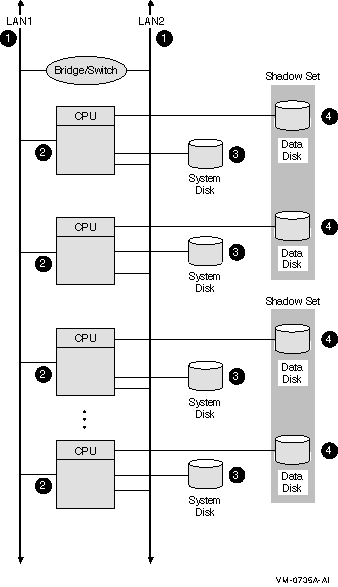
8.5.1 Components
The LAN OpenVMS Cluster configuration in Figure 8-1 has the
following components:
| Component |
Description |
|
1
|
Two Ethernet interconnects. For higher network capacity, use FDDI
interconnects instead of Ethernet.
Rationale: For redundancy, use at least two LAN
interconnects and attach all nodes to all LAN interconnects.
A single interconnect would introduce a single point of failure.
|
|
2
|
Three to eight Ethernet-capable OpenVMS nodes.
Each node has its own system disk so that it is not dependent on
another node.
Rationale: Use at least three nodes to maintain
quorum. Use fewer than eight nodes to avoid the complexity of managing
eight system disks.
Alternative 1: If you require satellite nodes,
configure one or two nodes as boot servers. Note, however, that the
availability of the satellite nodes is dependent on the availability of
the server nodes.
Alternative 2: For more than eight nodes, use a LAN
OpenVMS Cluster configuration as described in Section 8.10.
|
|
3
|
System disks.
System disks generally are not shadowed in LAN OpenVMS Clusters
because of boot-order dependencies.
Alternative 1: Shadow the system disk across two local
controllers.
Alternative 2: Shadow the system disk across two
nodes. The second node mounts the disk as a nonsystem disk.
Reference: See Section 11.2.4 for an explanation of
boot-order and satellite dependencies.
|
|
4
|
Essential data disks.
Use volume shadowing to create multiple copies of all essential
data disks. Place shadow set members on at least two nodes to eliminate
a single point of failure.
|
8.5.2 Advantages
This configuration offers the following advantages:
- Lowest cost of all the sample configurations shown in this chapter.
- Some potential for growth in size and performance.
- The LAN interconnect supports the widest choice of nodes.
8.5.3 Disadvantages
This configuration has the following disadvantages:
- No shared direct access to storage. The nodes are dependent on an
MSCP server for access to shared storage.
- Shadowing disks across the LAN nodes causes shadow copies when the
nodes boot.
- Shadowing the system disks is not practical because of boot-order
dependencies.
8.5.4 Key Availability Strategies
The configuration in Figure 8-1 incorporates the following
strategies, which are critical to its success:
- This configuration has no single point of failure.
- Volume shadowing provides multiple copies of essential data disks
across separate nodes.
- At least three nodes are used for quorum, so the OpenVMS Cluster
continues if any one node fails.
- Each node has its own system disk; there are no satellite
dependencies.
8.6 Configuring Multiple LANs
Follow these guidelines to configure a highly available multiple LAN
cluster:
- Bridge LAN segments together to form a single extended LAN.
- Provide redundant LAN segment bridges for failover support.
- Configure LAN bridges to pass the LAN and MOP multicast messages.
- Use the Local Area OpenVMS Cluster Network Failure Analysis Program
to monitor and maintain network availability. (See HP OpenVMS Cluster Systems for
more information.)
- Use the troubleshooting suggestions in HP OpenVMS Cluster Systems to diagnose
performance problems with the SCS layer and the NISCA transport
protocol.
- Keep LAN average utilization below 50%.
Reference: See Section 10.7.8 for information about
extended LANs (ELANs).
8.6.1 Selecting MOP Servers
When using multiple LAN adapters with multiple LAN segments, distribute
the connections to LAN segments that provide MOP service. The
distribution allows MOP servers to downline load satellites even when
network component failures occur.
It is important to ensure sufficient MOP servers for both VAX and Alpha
nodes to provide downline load support for booting satellites. By
careful selection of the LAN connection for each MOP server (Alpha or
VAX, as appropriate) on the network, you can maintain MOP service in
the face of network failures.
8.6.2 Configuring Two LAN Segments
Figure 8-2 shows a sample configuration for an OpenVMS Cluster
system connected to two different LAN segments. The configuration
includes Alpha and VAX nodes, satellites, and two bridges.
Figure 8-2 Two-LAN Segment OpenVMS Cluster
Configuration
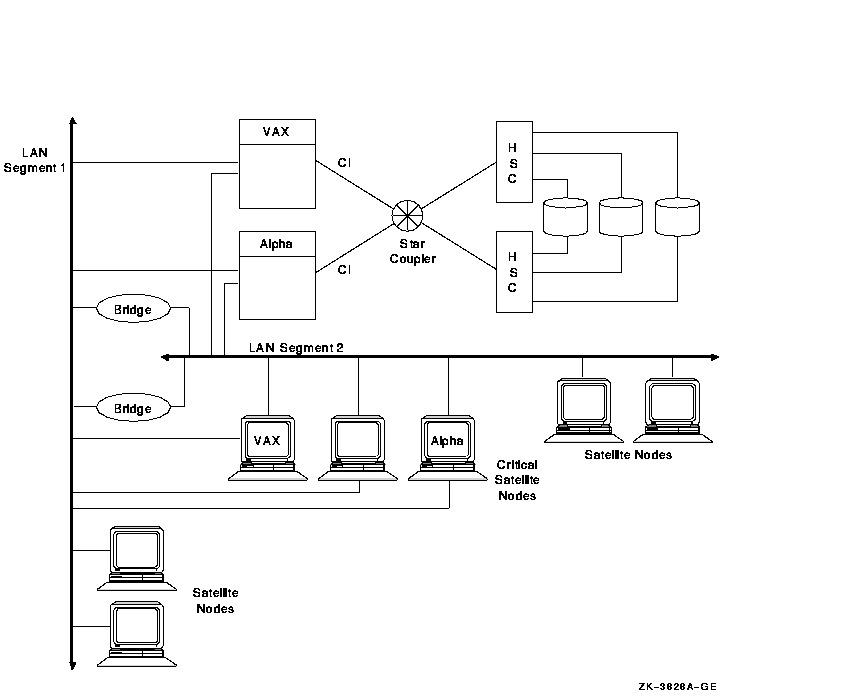
The figure illustrates the following points:
- Connecting critical nodes to multiple LAN segments provides
increased availability in the event of segment or adapter failure. Disk
and tape servers can use some of the network bandwidth provided by the
additional network connection. Critical satellites can be booted using
the other LAN adapter if one LAN adapter fails.
- Connecting noncritical satellites to only one LAN segment helps to
balance the network load by distributing systems equally among the LAN
segments. These systems communicate with satellites on the other LAN
segment through one of the bridges.
- Only one LAN adapter per node can be used for DECnet and MOP
service to prevent duplication of LAN addresses.
- LAN adapters providing MOP service (Alpha or VAX, as appropriate)
should be distributed among the LAN segments to ensure that LAN
failures do not prevent satellite booting.
- Using redundant LAN bridges prevents the bridge from being a
single point of failure.
8.6.3 Configuring Three LAN Segments
Figure 8-3 shows a sample configuration for an OpenVMS Cluster
system connected to three different LAN segments. The configuration
also includes both Alpha and VAX nodes and satellites and multiple
bridges.
Figure 8-3 Three-LAN Segment OpenVMS Cluster
Configuration
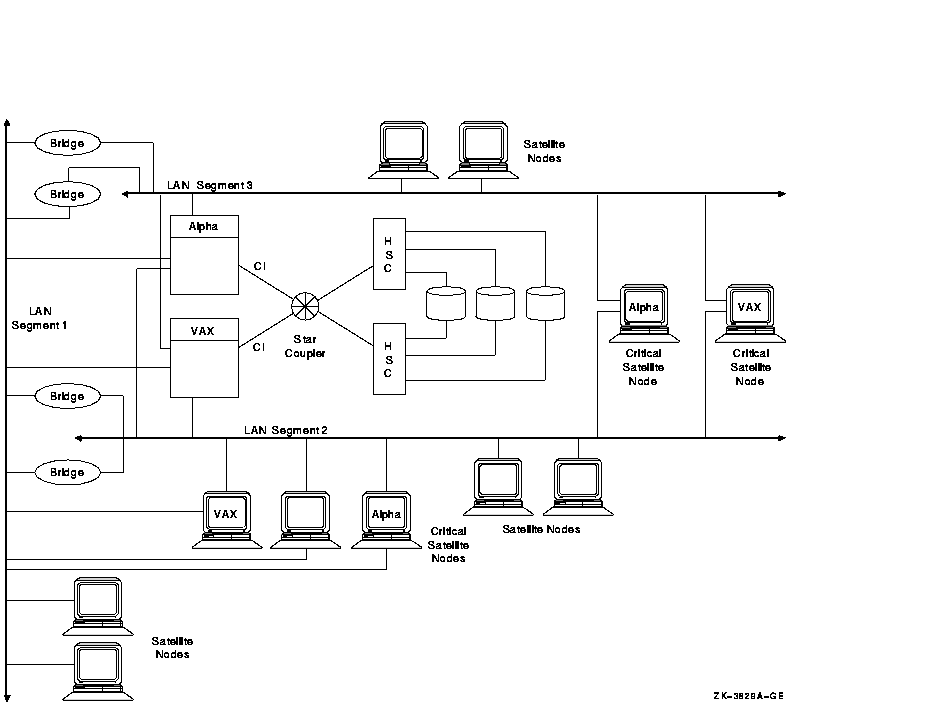
The figure illustrates the following points:
- Connecting disk and tape servers to two or three LAN segments can
help provide higher availability and better I/O throughput.
- Connecting critical satellites to two or more LAN segments can
also increase availability. If any of the network components fails,
these satellites can use the other LAN adapters to boot and still have
access to the critical disk servers.
- Distributing noncritical satellites equally among the LAN segments
can help balance the network load.
- A MOP server (Alpha or VAX, as appropriate) is provided for each
LAN segment.
Reference: See Section 11.2.4 for more information
about boot order and satellite dependencies in a LAN. See HP OpenVMS Cluster Systems
for information about LAN bridge failover.
8.7 Availability in a DSSI OpenVMS Cluster
Figure 8-4 shows an optimal configuration for a medium-capacity,
highly available DSSI OpenVMS Cluster system. Figure 8-4 is followed
by an analysis of the configuration that includes:
- Analysis of its components
- Advantages and disadvantages
- Key availability strategies implemented
Figure 8-4 DSSI OpenVMS Cluster System
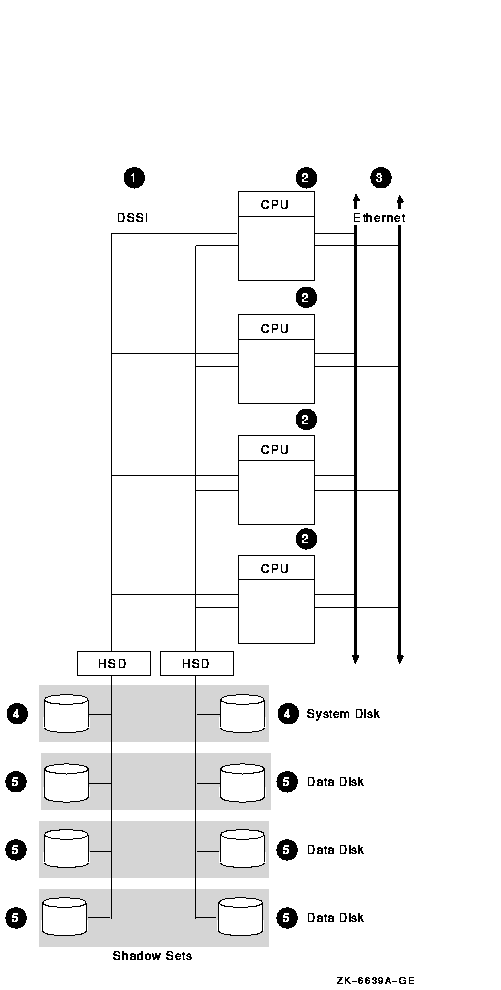
8.7.1 Components
The DSSI OpenVMS Cluster configuration in Figure 8-4 has the
following components:
| Part |
Description |
|
1
|
Two DSSI interconnects with two DSSI adapters per node.
Rationale: For redundancy, use at least two
interconnects and attach all nodes to all DSSI interconnects.
|
|
2
|
Two to four DSSI-capable OpenVMS nodes.
Rationale: Three nodes are recommended to maintain
quorum. A DSSI interconnect can support a maximum of four OpenVMS nodes.
Alternative 1: Two-node configurations require a
quorum disk to maintain quorum if a node fails.
Alternative 2: For more than four nodes, configure two
DSSI sets of nodes connected by two LAN interconnects.
|
|
3
|
Two Ethernet interconnects.
Rationale: The LAN interconnect is required for
DECnet--Plus communication. Use two interconnects for redundancy. For
higher network capacity, use FDDI instead of Ethernet.
|
|
4
|
System disk.
Shadow the system disk across DSSI interconnects.
Rationale: Shadow the system disk across interconnects
so that the disk and the interconnect do not become single points of
failure.
|
|
5
|
Data disks.
Shadow essential data disks across DSSI interconnects.
Rationale: Shadow the data disk across interconnects
so that the disk and the interconnect do not become single points of
failure.
|
8.7.2 Advantages
The configuration in Figure 8-4 offers the following advantages:
- The DSSI interconnect gives all nodes shared, direct access to all
storage.
- Moderate potential for growth in size and performance.
- There is only one system disk to manage.
8.7.3 Disadvantages
This configuration has the following disadvantages:
- Applications must be shut down in order to swap DSSI cables. This
is referred to as "warm swap." The DSSI cable is warm
swappable for the adapter, the cable, and the node.
- A node's location on the DSSI affects the recoverability of the
node. If the adapter fails on a node located at the end of the DSSI
interconnect, the OpenVMS Cluster may become unavailable.
8.7.4 Key Availability Strategies
The configuration in Figure 8-4 incorporates the following
strategies, which are critical to its success:
- This configuration has no single point of failure.
- Volume shadowing provides multiple copies of system and essential
data disks across separate DSSI interconnects.
- All nodes have shared, direct access to all storage.
- At least three nodes are used for quorum, so the OpenVMS Cluster
continues if any one node fails.
- There are no satellite dependencies.
8.8 Availability in a CI OpenVMS Cluster
Figure 8-5 shows an optimal configuration for a large-capacity,
highly available CI OpenVMS Cluster system. Figure 8-5 is followed
by an analysis of the configuration that includes:
- Analysis of its components
- Advantages and disadvantages
- Key availability strategies implemented
Figure 8-5 CI OpenVMS Cluster System
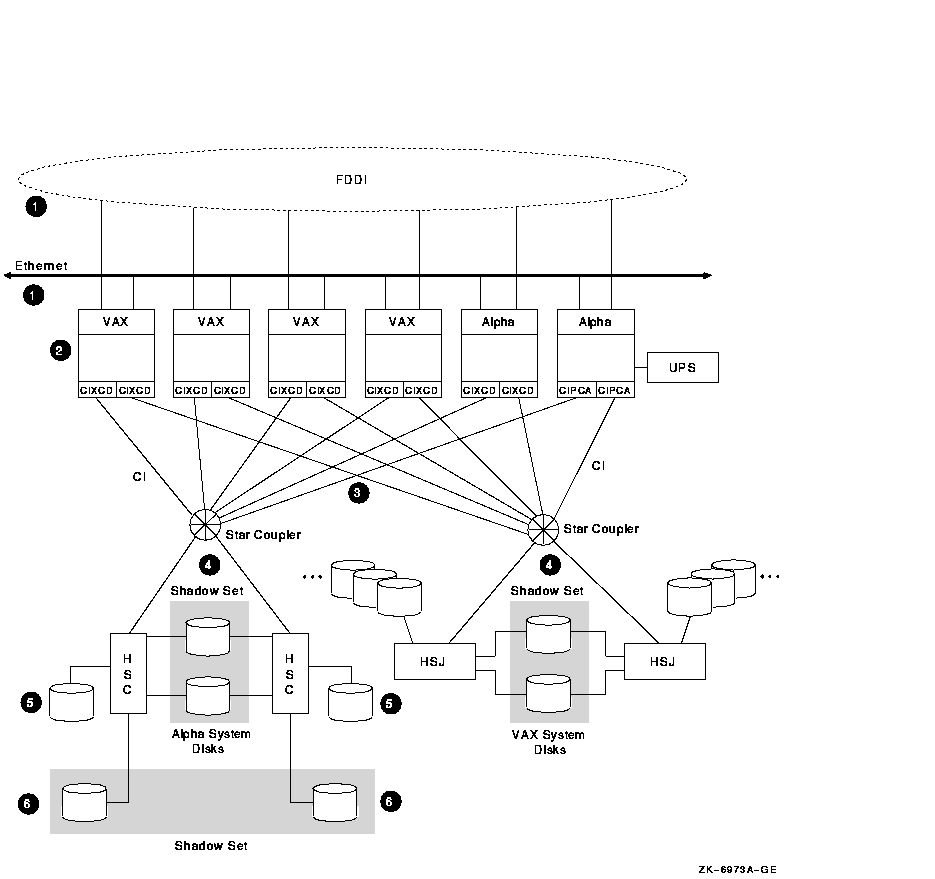
8.8.1 Components
The CI OpenVMS Cluster configuration in Figure 8-5 has the following
components:
| Part |
Description |
|
1
|
Two LAN interconnects.
Rationale: The additional use of LAN interconnects is
required for DECnet--Plus communication. Having two LAN
interconnects---Ethernet or FDDI---increases redundancy. For higher
network capacity, use FDDI instead of Ethernet.
|
|
2
|
Two to 16 CI capable OpenVMS nodes.
Rationale: Three nodes are recommended to maintain
quorum. A CI interconnect can support a maximum of 16 OpenVMS nodes.
Reference: For more extensive information about the
CIPCA, see Appendix C.
Alternative: Two-node configurations require a quorum
disk to maintain quorum if a node fails.
|
|
3
|
Two CI interconnects with two star couplers.
Rationale: Use two star couplers to allow for
redundant connections to each node.
|
|
4
|
Critical disks are dual ported between CI storage controllers.
Rationale: Connect each disk to two controllers for
redundancy. Shadow and dual port system disks between CI storage
controllers. Periodically alternate the primary path of dual-ported
disks to test hardware.
|
|
5
|
Data disks.
Rationale: Single port nonessential data disks, for
which the redundancy provided by dual porting is unnecessary.
|
|
6
|
Essential data disks are shadowed across controllers.
Rationale: Shadow essential disks and place shadow set
members on different HSCs to eliminate a single point of failure.
|
8.8.2 Advantages
This configuration offers the following advantages:
- All nodes have direct access to all storage.
- This configuration has a high growth capacity for processing and
storage.
- The CI is inherently dual pathed, unlike other interconnects.
8.8.3 Disadvantages
This configuration has the following disadvantage:
- Higher cost than the other configurations.
8.8.4 Key Availability Strategies
The configuration in Figure 8-5 incorporates the following
strategies, which are critical to its success:
- This configuration has no single point of failure.
- Dual porting and volume shadowing provides multiple copies of
essential disks across separate HSC or HSJ controllers.
- All nodes have shared, direct access to all storage.
- At least three nodes are used for quorum, so the OpenVMS Cluster
continues if any one node fails.
- There are no satellite dependencies.
- The uninterruptible power supply (UPS) ensures availability in case
of a power failure.
8.9 Availability in a MEMORY CHANNEL OpenVMS Cluster
Figure 8-6 shows a highly available MEMORY CHANNEL (MC) cluster
configuration. Figure 8-6 is followed by an analysis of the
configuration that includes:
- Analysis of its components
- Advantages and disadvantages
- Key availability strategies implemented
Figure 8-6 MEMORY CHANNEL Cluster
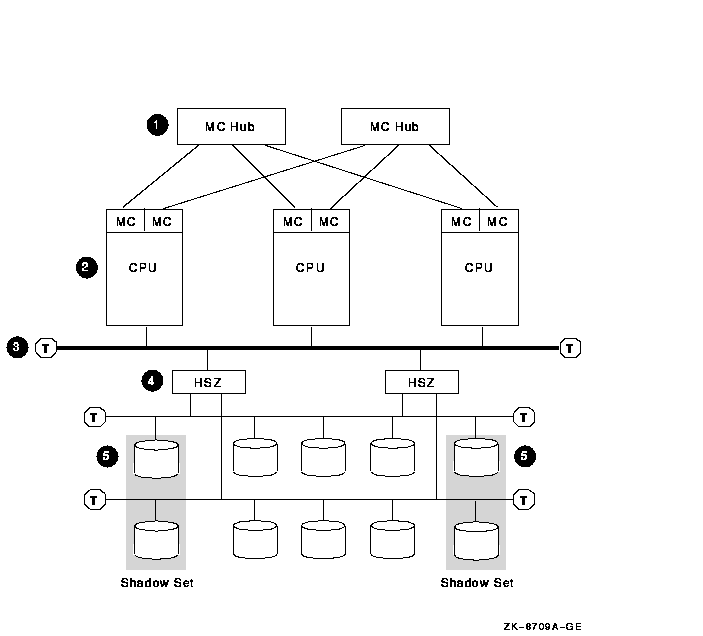
8.9.1 Components
The MEMORY CHANNEL configuration shown in Figure 8-6 has the
following components:
| Part |
Description |
|
1
|
Two MEMORY CHANNEL hubs.
Rationale: Having two hubs and multiple connections to
the nodes prevents having a single point of failure.
|
|
2
|
Three to eight MEMORY CHANNEL nodes.
Rationale: Three nodes are recommended to maintain
quorum. A MEMORY CHANNEL interconnect can support a maximum of eight
OpenVMS Alpha nodes.
Alternative: Two-node configurations require a quorum
disk to maintain quorum if a node fails.
|
|
3
|
Fast-wide differential (FWD) SCSI bus.
Rationale: Use a FWD SCSI bus to enhance data transfer
rates (20 million transfers per second) and because it supports up to
two HSZ controllers.
|
|
4
|
Two HSZ controllers.
Rationale: Two HSZ controllers ensure redundancy in
case one of the controllers fails. With two controllers, you can
connect two single-ended SCSI buses and more storage.
|
|
5
|
Essential system disks and data disks.
Rationale: Shadow essential disks and place shadow set
members on different SCSI buses to eliminate a single point of failure.
|
8.9.2 Advantages
This configuration offers the following advantages:
- All nodes have direct access to all storage.
- SCSI storage provides low-cost, commodity hardware with good
performance.
- The MEMORY CHANNEL interconnect provides high-performance,
node-to-node communication at a low price. The SCSI interconnect
complements MEMORY CHANNEL by providing low-cost, commodity storage
communication.
8.9.3 Disadvantages
This configuration has the following disadvantage:
- The fast-wide differential SCSI bus is a single point of failure.
One solution is to add a second, fast-wide differential SCSI bus so
that if one fails, the nodes can fail over to the other. To use this
functionality, the systems must be running OpenVMS Version 7.2 or
higher and have multipath support enabled.
8.9.4 Key Availability Strategies
The configuration in Figure 8-6 incorporates the following
strategies, which are critical to its success:
- Redundant MEMORY CHANNEL hubs and HSZ controllers prevent a single
point of hub or controller failure.
- Volume shadowing provides multiple copies of essential disks across
separate HSZ controllers.
- All nodes have shared, direct access to all storage.
- At least three nodes are used for quorum, so the OpenVMS Cluster
continues if any one node fails.
8.10 Availability in an OpenVMS Cluster with Satellites
Satellites are systems that do not have direct access to a system disk
and other OpenVMS Cluster storage. Satellites are usually workstations,
but they can be any OpenVMS Cluster node that is served storage by
other nodes in the cluster.
Because satellite nodes are highly dependent on server nodes for
availability, the sample configurations presented earlier in this
chapter do not include satellite nodes. However, because
satellite/server configurations provide important advantages, you may
decide to trade off some availability to include satellite nodes in
your configuration.
Figure 8-7 shows an optimal configuration for a OpenVMS Cluster
system with satellites. Figure 8-7 is followed by an analysis of the
configuration that includes:
- Analysis of its components
- Advantages and disadvantages
- Key availability strategies implemented
The base configurations in Figure 8-4 and Figure 8-5 could
replace the base configuration shown in Figure 8-7. In other words,
the FDDI and satallite segments shown in Figure 8-7 could just as
easily be attached to the configurations shown in Figure 8-4 and
Figure 8-5.
Figure 8-7 OpenVMS Cluster with Satellites
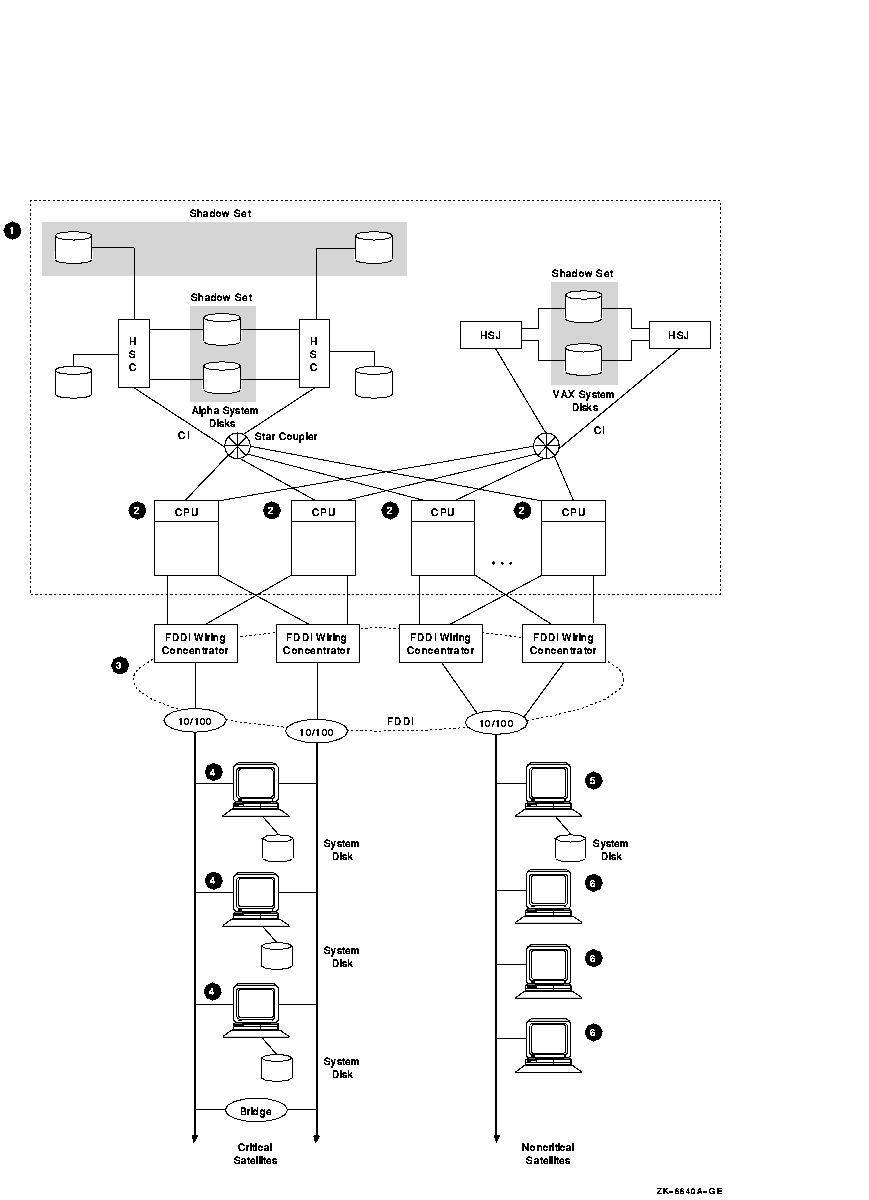
8.10.1 Components
This satellite/server configuration in Figure 8-7 has the following
components:
| Part |
Description |
|
1
|
Base configuration.
The base configuration performs server functions for satellites.
|
|
2
|
Three to 16 OpenVMS server nodes.
Rationale: At least three nodes are recommended to
maintain quorum. More than 16 nodes introduces excessive complexity.
|
|
3
|
FDDI ring between base server nodes and satellites.
Rationale: The FDDI ring has increased network
capacity over Ethernet, which is slower.
Alternative: Use two Ethernet segments instead of the
FDDI ring.
|
|
4
|
Two Ethernet segments from the FDDI ring to attach each critical
satellite with two Ethernet adapters. Each of these critical satellites
has its own system disk.
Rationale: Having their own boot disks increases the
availability of the critical satellites.
|
|
5
|
For noncritical satellites, place a boot server on the Ethernet segment.
Rationale: Noncritical satellites do not need their
own boot disks.
|
|
6
|
Limit the satellites to 15 per segment.
Rationale: More than 15 satellites on a segment may
cause I/O congestion.
|
8.10.2 Advantages
This configuration provides the following advantages:
- A large number of nodes can be served in one OpenVMS Cluster.
- You can spread a large number of nodes over a greater distance.
8.10.3 Disadvantages
This configuration has the following disadvantages:
- Satellites with single LAN adapters have a single point of failure
that causes cluster transitions if the adapter fails.
- High cost of LAN connectivity for highly available satellites.
|






